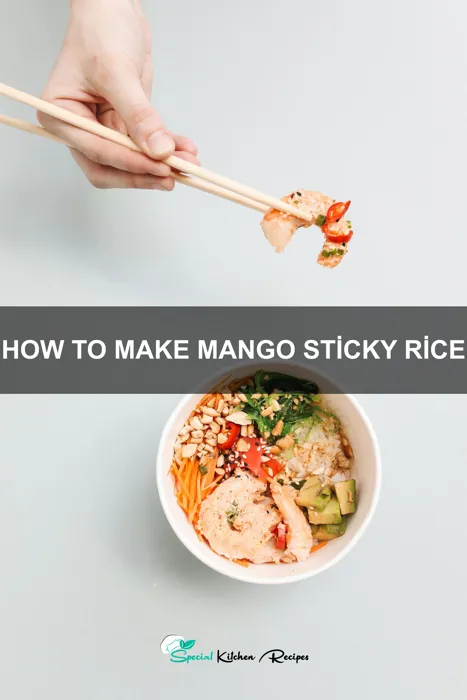Prepare to embark on a culinary journey to Thailand with this guide on how to make Mango Sticky Rice, a dessert so iconic it’s practically synonymous with the country’s vibrant cuisine. Mango sticky rice, or khao niew ma muang in Thai, isn’t just a dessert; it’s a cultural cornerstone. Its origins are deeply rooted in Thai history, emerging from the abundance of both mangoes and glutinous rice, staples in the Thai diet for centuries. While the exact date of its inception remains elusive, its popularity exploded in the late 20th century, propelled by tourism and the global fascination with Thai flavors.
The dish’s simplicity belies its profound cultural significance. It’s frequently served at celebrations, festivals, and special occasions, symbolizing sweetness, prosperity, and good fortune. The vibrant yellow of the ripe mango contrasts beautifully with the pearly white of the sticky rice, creating a visually stunning presentation that mirrors the harmony and balance sought in Thai culture. Interestingly, the choice of mango variety is often significant, with certain types considered more auspicious than others. The dish’s popularity is undeniable; online searches for mango sticky rice recipe number in the millions annually, a testament to its global appeal.
Beyond its cultural importance, mango sticky rice boasts a unique textural and flavor profile that captivates the palate. The soft, chewy texture of the sweet sticky rice, infused with coconut milk, provides a delightful contrast to the juicy sweetness of the ripe mango. Often, a drizzle of coconut cream and a sprinkle of toasted sesame seeds are added, further enhancing the sensory experience. The combination of these ingredients creates a balanced symphony of flavors – sweet, creamy, and subtly nutty – making it a truly unforgettable dessert. This recipe will guide you step-by-step through the process, allowing you to recreate this beloved Thai treat in your own kitchen.
Ingredients and Measurements
Creating the perfect Mango Sticky Rice requires careful attention to ingredient quality and precise measurements. Using ripe, fragrant mangoes is crucial for optimal flavor, and the type of rice you choose will significantly impact the texture of your final dish.
For the Sticky Rice, you will need:
- 1 cup (200g) glutinous rice (also known as sweet rice or sticky rice). Ensure you rinse the rice thoroughly under cold water until the water runs clear. This removes excess starch and prevents clumping.
- 1 cup (240ml) coconut milk. Use full-fat coconut milk for the richest flavor and creaminess. Light coconut milk will result in a less rich dish.
- 1/2 cup (100g) granulated sugar. Adjust to your preference; some prefer a sweeter sticky rice.
- 1/4 teaspoon salt. A pinch of salt enhances the sweetness.
- 1 tablespoon vegetable oil or coconut oil. This helps prevent sticking.
For the Mango, you will need:
- 2 ripe mangoes (about 1 pound/450g total). Choose mangoes that are fragrant and yield slightly to gentle pressure. Ataulfo mangoes (honey mangoes) are particularly well-suited for this recipe due to their sweetness and softer texture.
For the Coconut Milk Topping (optional but highly recommended):
- 1/2 cup (120ml) full-fat coconut milk
- 2 tablespoons granulated sugar (adjust to taste)
- 1/4 teaspoon salt
For the Sesame Seeds (optional garnish):
- 1-2 tablespoons toasted sesame seeds
Important Note: Measurements can vary slightly depending on the size of your mangoes and rice grains. Always taste and adjust sweetness levels to your liking. The success of this recipe lies in the quality of your ingredients and your attention to detail in the cooking process. Don’t rush the process; allow ample time for the rice to cook properly and absorb the coconut milk.
Preparing the Mango
Selecting the perfect mango is crucial for the best-tasting sticky rice. Look for mangoes that are firm yet slightly yielding to gentle pressure. Avoid mangoes that are bruised, overly soft, or have blemishes. For a recipe serving two, you’ll need approximately two ripe mangoes, or about 1 pound total. The variety of mango you choose is a matter of personal preference; Ataulfo mangoes are known for their sweetness and softer texture, while Tommy Atkins mangoes offer a firmer texture and slightly tangier flavor.
Once you’ve chosen your mangoes, it’s time to prepare them. Begin by washing the mangoes thoroughly under cold running water to remove any dirt or residue. Use a sharp knife to carefully slice the mangoes along their natural curve, following the large, flat seed in the center. Avoid cutting too deep into the seed, as this can make it difficult to remove cleanly and waste valuable mango flesh.
After slicing the mango into two halves, use a spoon or a paring knife to carefully remove the large, flat pit from the center of each half. Discard the pit. Now, you have two halves of mango flesh, ready to be cut into smaller, more manageable pieces.
The method for cutting the mango flesh depends on your preference and the final presentation of your dish. You can slice the mango flesh into thin, elegant slices, ideal for a more refined presentation. Alternatively, you can dice the mango into smaller cubes, which are easier to eat and distribute evenly throughout the sticky rice. For a balanced approach, we recommend a combination: slice the mango into relatively wide slices (about 1/2 inch thick), then cut these slices into 1-inch pieces. This provides visual appeal while also ensuring easy consumption.
After cutting the mangoes, you might choose to gently pat them dry with a paper towel to remove any excess moisture. This can help prevent the sticky rice from becoming overly watery. However, a small amount of moisture is natural and contributes to the overall flavor. Don’t overdo the drying process. Once your mangoes are prepped, set them aside and proceed with preparing the sticky rice and coconut milk mixture.
Important Note: The ripeness of your mangoes will influence the sweetness of your dish. If your mangoes are less ripe, you may want to add a touch of extra sugar to the sticky rice to balance the flavors.
Cooking the Sticky Rice
Cooking perfect sticky rice is crucial for a delicious Mango Sticky Rice. The key is to soak the rice properly and cook it gently to achieve that wonderfully chewy texture. We’ll be using 1 cup of glutinous rice (also known as sweet rice or sticky rice) for this recipe.
Begin by rinsing the rice thoroughly. Place the 1 cup of glutinous rice in a fine-mesh sieve and rinse under cold running water until the water runs clear. This removes excess starch and helps prevent the rice from becoming too sticky and clumpy. This rinsing process should take about 2-3 minutes.
Soaking is essential. After rinsing, transfer the rice to a medium-sized bowl and cover it with at least 2 cups of cold water. Soak the rice for at least 4 hours, or ideally, overnight. This allows the rice to absorb water fully, resulting in a softer, more evenly cooked texture. If you’re short on time, a minimum of 2 hours is acceptable, but overnight soaking is strongly recommended.
Cooking the rice. Once soaked, drain the rice completely. Transfer it to a medium saucepan and add 1 ¼ cups of water. Give it a gentle stir to distribute the water evenly. Bring the water to a boil over high heat, then immediately reduce the heat to the lowest setting possible. Cover the saucepan tightly with a lid. This is vital to trap the steam and ensure the rice cooks evenly.
Simmering is key. Simmer the rice gently for about 15-20 minutes, or until all the water is absorbed and the rice is cooked through. Do not lift the lid during this process, as this will release steam and affect the cooking. After 15 minutes, check for doneness by gently inserting a fork into the center of the rice. If it comes out clean and the rice is tender, it’s ready. If not, continue simmering for a few more minutes, checking periodically.
Resting for fluffiness. Once cooked, remove the saucepan from the heat and let the rice rest, still covered, for another 10-15 minutes. This allows the steam to fully cook the rice and creates a lovely, fluffy texture. Gently fluff the rice with a fork before serving to separate the grains.
Important Note: The cooking time may vary slightly depending on your stove and the type of rice used. Always check the rice for doneness before removing it from the heat. Slightly undercooked rice is better than overcooked rice, as it will continue to cook with the residual heat. Overcooked rice will become mushy.
Making the Coconut Milk Sauce
The coconut milk sauce is the heart and soul of Mango Sticky Rice, providing a luscious, creamy counterpoint to the sweetness of the mango and the chewiness of the rice. Making it correctly is crucial for a truly authentic and delicious dish. We’ll be using full-fat coconut milk for the richest flavor and texture. Avoid using light coconut milk, as it won’t provide the same creamy richness.
Begin by gathering your ingredients: 1 (13.5 ounce) can of full-fat coconut milk, 1/2 cup of granulated sugar, 1/4 cup of water, and a pinch of salt. Ensure your coconut milk is well-shaken before opening to avoid separation. This will ensure a smooth and consistent sauce.
In a medium saucepan over medium heat, combine the coconut milk, sugar, water, and salt. Stir gently to dissolve the sugar. Do not boil the mixture vigorously; a gentle simmer is key. Boiling can cause the sauce to curdle and separate, ruining its texture and appearance.
Once the sugar has completely dissolved and the mixture begins to simmer, reduce the heat to low. Continue to simmer gently, stirring occasionally, for about 5-7 minutes. This allows the flavors to meld and the sauce to slightly thicken. Do not overcook; the sauce should remain relatively thin and pourable, not thick and syrupy.
To check for the correct consistency, spoon a small amount of the sauce onto a plate. Let it cool for a few seconds. It should coat the back of the spoon lightly but not be overly thick. If it’s too thick, add a tablespoon or two of water and continue to simmer gently. If it’s too thin, continue simmering for a few more minutes, stirring frequently.
Once the sauce has reached the desired consistency, remove it from the heat and let it cool completely. Cooling allows the flavors to fully develop and the sauce to thicken further. Once cooled, the sauce can be stored in the refrigerator for up to 3 days. Before serving, gently reheat the sauce if needed, but avoid boiling it again.
Your creamy, delicious coconut milk sauce is now ready to be poured generously over your perfectly cooked sticky rice and ripe mango slices. Enjoy!
Combining and Serving
Once your sticky rice is cooked and your mango is prepared, it’s time to bring this delicious dessert together. The key to a perfect Mango Sticky Rice is achieving the right balance of textures and flavors. This involves careful combining and artful presentation.
Begin by preparing your serving dishes. Individual bowls or ramekins work best for this dessert, allowing for a beautiful presentation. For approximately 4 servings, you’ll need 4 individual bowls. Ensure your bowls are at room temperature or slightly warmed; this will help prevent the sticky rice from cooling down too quickly.
Next, gently spoon approximately 1/2 cup of the cooked sticky rice into each bowl. Avoid packing the rice down too tightly; you want it to retain its fluffy texture. Spread the rice evenly in the bowl to create a base layer.
Now comes the star of the show – the mango. Cut your ripe mango into bite-sized pieces or slices. You’ll need approximately 1 medium-sized ripe mango (about 1.5 cups diced) for four servings. Arrange the mango pieces attractively on top of the sticky rice. Consider creating a visually appealing pattern or simply scattering the mango pieces evenly across the rice.
The final touch is the coconut milk sauce. Carefully pour the prepared coconut milk sauce over the mango and sticky rice. Start with a moderate amount, about 2-3 tablespoons per serving, and add more if desired. You want the sauce to coat the rice and mango without making it too soggy. The sauce should be warm, but not hot, to avoid cooking the mango.
For an extra touch of luxury, consider garnishing each serving with toasted sesame seeds (about 1 teaspoon per serving), a sprinkle of chopped roasted peanuts (about 1 tablespoon per serving), or a few fresh mint leaves. These additions add a delightful crunch and aromatic complexity.
Serve your Mango Sticky Rice immediately for the best experience. The warmth of the rice and sauce, combined with the cool sweetness of the mango, creates a truly unforgettable taste sensation. Enjoy!
Professional Tip: For a more sophisticated presentation, consider using a piping bag to create a decorative swirl of coconut milk sauce over the rice and mango. This adds a touch of elegance to an already beautiful dessert.
Tips for the Best Mango Sticky Rice
Making truly exceptional mango sticky rice hinges on attention to detail. These tips will elevate your dish from good to unforgettable.
Use high-quality ingredients: This is paramount. Start with fragrant Thai jasmine rice designed for sticky rice dishes. The quality of your rice directly impacts the texture and overall experience. Look for brands specifically labeled as sticky rice or sweet rice. Similarly, choose ripe, but not overripe, mangoes. Perfectly ripe mangoes will be fragrant and yield a sweet, juicy flesh. Avoid mangoes that are bruised or overly soft.
Rinse your rice thoroughly: Before cooking, rinse your sticky rice in several changes of cold water until the water runs clear. This removes excess starch and prevents the rice from becoming overly gummy. This step is crucial for achieving the perfect texture.
Proper soaking: Soaking the rice for at least 30 minutes, or up to 2 hours, is highly recommended. This allows the rice to absorb water evenly, resulting in a more tender and less sticky texture. Do not skip this step!
Control the cooking process: When steaming the rice, ensure the steamer basket is well-ventilated to allow steam to circulate freely. Over-steaming can lead to mushy rice. Aim for a cooking time of approximately 20-25 minutes, or until the rice is fully cooked and tender but not mushy. Check for doneness by gently pressing a grain of rice; it should be soft and slightly sticky.
Master the coconut milk mixture: The coconut milk sauce is just as important as the rice. Use full-fat coconut milk for the richest flavor and creaminess. For a truly authentic taste, add a pinch of salt to balance the sweetness. Adjust the sugar to your preference – start with 1/4 cup of sugar for 1 cup of coconut milk, and add more to taste. A little extra sugar is usually needed to balance the sweetness and tang of the mangoes.
Serve immediately: Mango sticky rice is best enjoyed fresh. The sticky rice tends to harden as it cools, making it less enjoyable. Serve immediately after preparing the coconut milk sauce and arranging the mango slices. Garnish with toasted sesame seeds for an added touch of flavor and texture. Consider serving it warm for the ultimate experience.
Mango preparation: Choose mangoes that are ripe but firm. Slice them carefully to avoid bruising the flesh. The presentation of the mango slices is also important – neatly arranged slices add to the overall aesthetic appeal of the dish.
By following these tips, you’ll be well on your way to creating a truly memorable mango sticky rice experience.
Recommendations
For the best tasting Mango Sticky Rice, use ripe, but firm mangoes. Overripe mangoes can become too mushy and affect the overall texture of the dessert. The sweetness of the mangoes will also vary, so you may need to adjust the amount of sugar in the coconut milk accordingly. Taste the coconut milk mixture before adding it to the rice and sweeten to your preference.
Serving suggestions are endless! This delightful dish is perfect as it is, but you can elevate it further. Consider garnishing with toasted sesame seeds, shredded coconut, or a drizzle of extra coconut milk for added richness and visual appeal. A sprinkle of chopped fresh mint adds a refreshing contrast.
Storage: Leftover Mango Sticky Rice should be stored in an airtight container in the refrigerator for up to 3 days. Reheat gently in the microwave or on the stovetop, adding a splash of coconut milk if needed to restore moisture. Avoid over-heating, as this can dry out the rice.
Complementary dishes: Mango Sticky Rice pairs beautifully with other Southeast Asian flavors. Consider serving it alongside a light and refreshing Thai green curry, or a flavorful Tom Yum soup for a balanced meal. It also complements sweeter options like Thai tea or a scoop of coconut ice cream.
Nutritional Information (approximate per serving, varies with ingredients): Calories: 350-450, Carbohydrates: 70-80g, Fat: 15-20g, Protein: 5-7g. Note: This is an estimate and the actual nutritional content will vary depending on the specific ingredients used and serving size. This dessert is naturally high in carbohydrates and sugars, so it should be enjoyed in moderation.
Important Tip: Don’t be afraid to experiment! Feel free to adjust the sweetness and coconut milk consistency to your liking. The beauty of this recipe lies in its adaptability to individual preferences.





